Table of Contents
The Buckman Tilting Concentrator is a development of the engineering staff of the Consolidated Mining and Smelting Co. of Canada, Ltd. It is named after Mr. R. S. Buckman, the mechanical superintendent at the Sullivan Concentrator. Over one million tons of material were handled by these machines before being offered as a tried and proved product by the Equipment Company, sales licensee.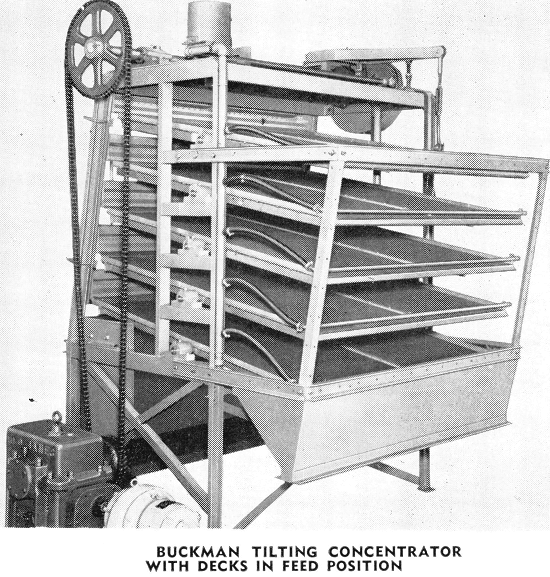
Application
A feasible and economical means of concentration of fine particles of heavy specific gravity minerals, not readily concentrated by flotation is offered by this machine. Native metals, oxides, and tarnished material can be treated. Size range most suitable is 150 to 1000 mesh. The machine is used for:
- Treatment of low grade placer deposits where valuable minerals are approximately 150 mesh.
- Retreatment of tailing dumps.
- Increasing recoveries in slime sections of gravity concentration plants.
It is an ideal unit for concentration of such minerals as cassiterite, wolframite, scheelite, gold, various oxides and tarnished minerals such as contained in old mill tailings.
Buckman Tilting Concentrator Working Principle
The basic principle of the Buckman Tilting Concentrator is the mechanical tilting, spraying, and return of the unit. By a simple control system, the action of several units is so coordinated that the feed to the system is continuous.
A typical installation consists of 1100 tons of pulp a day being fed to a ten-way distributor feeding ten blanket frame units. These units operate in a five-minute cycle. Two of the ten units are tilted simultaneously to a 45° slope, at which position the concentrate is removed by an automatic flush water system. Within one minute the frames have returned to the feed position and receive feed for four minutes. The total area is 1800 square feet, but only 1440 square feet receive feed at any time. The rotating cut-off trays of the distributor deflect two of the ten streams back to the feed pump.
The tilting of the deck, the distributor cut-off trays, and the flush water valves are synchronized mechanically through a common drive. Considering the ten frames as a whole, both feed pulp flow and concentrate discharge are continuous.
Buckman Tilting Concentrator Specifications
Size of decks…………………………………………………………………………………………………………..6′ x 6′
Number of decks…………………………………………………………………………………………………….5
Approximate capacity, tons solids per 24 hours…………………………………………………………..150-1000
Per cent solids in feed……………………………………………………………………………………………..17-25
Flush water, tons per 24 hours per unit………………………………………………………………………30-45
Domestic shipping weight, lbs…………………………………………………………………………………..4150
Export shipping weight, lbs……………………………………………………………………………………….4300
H.P. required for each circuit of 1 to 10 units……………………………………………………………….1
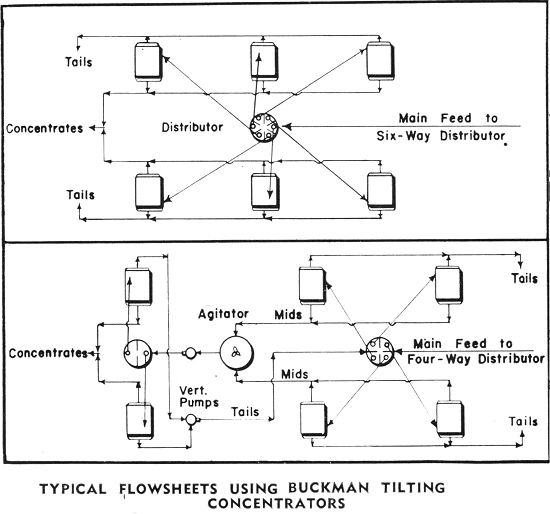
Buckman Tilting Concentrator was developed by a large mining company in Western Canada for concentrating very fine high-specific gravity minerals. It is used for cassiterite, wolframite, scheelite, and free milling gold ores in the 150-1000 mesh range.
Buckman Tilting Concentrator is a continuous feed distribution system synchronized in operation with one or more concentrator units. A mechanically controlled cycle of operations for each unit develops a continuous performance in the concentrator. Automatically the feed to each unit is cut off, the unit tilted, washed by high pressure water sprays, and then returned to its original position. Five to ten units can be operated from one distributor. Cleaner circuits may be operated in unison with rougher circuits.
The Buckman Tilting Concentrator fills a definite need for a unit to increase efficiency of slime sections of gravity plants. An extremely small operating crew, combined with low maintenance costs and high ratio of concentration have been reported by many enthusiastic users.
Additional data gladly furnished upon request.
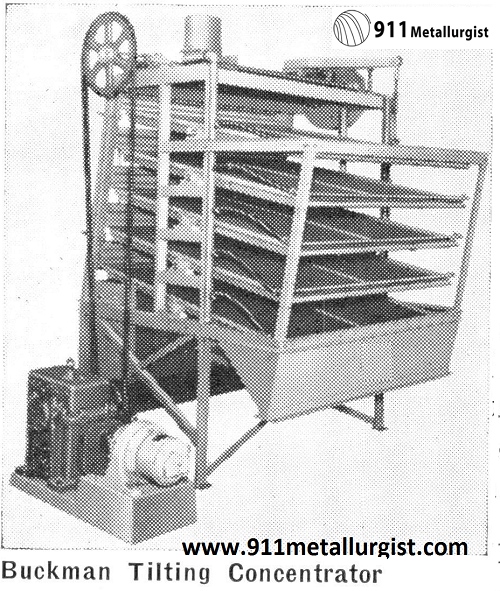

Centrifugal Concentrator consists of a sturdy bowl mounted on a vertical shaft. In operation, the bowl rotates with the placer sands and water fed into the bottom. Centrifugal force thus developed crowds the pulp to the periphery forcing it to flow upward over a series of riffles on the inner surface. Riffles are either machined into the bowl or are preferably rubber riffles cemented to the bowl. Gold and heavy minerals such as tin, tungsten, etc., accumulate in the riffles, the sand and water being discharged over the top edge of the bowl.
Centrifugal Concentrator is available in sizes from 12″ in diameter to 36″ in diameter. It is impossible to give definite capacity figures, as placer requirements vary over wide limits. It is therefore recommended that samples of placer sand be submitted to our laboratory for inspection, testing, and recommendations.
Power requirements are low and drives are available for gasoline engine, electric motor, or the bowl may be supplied with a shaft extension for coupling to any power source.
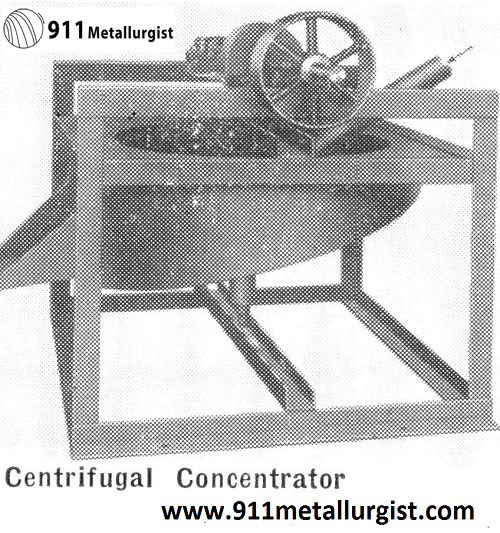
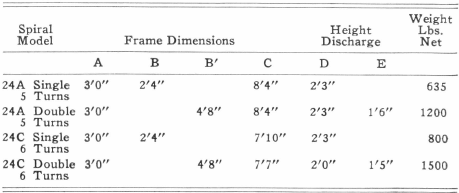
Source: This article is a reproduction of an excerpt of “In the Public Domain” documents held in 911Metallurgy Corp’s private library.
